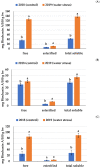Chickpeas from a Chilean Region Affected by a Climate-Related Catastrophe: Effects of Water Stress on Grain Yield and Flavonoid Composition
- PMID: 35163956
- PMCID: PMC8840598
- DOI: 10.3390/molecules27030691
Chickpeas from a Chilean Region Affected by a Climate-Related Catastrophe: Effects of Water Stress on Grain Yield and Flavonoid Composition
Abstract
The Valparaiso region in Chile was decreed a zone affected by catastrophe in 2019 as a consequence of one of the driest seasons of the last 50 years. In this study, three varieties ('Alfa-INIA', 'California-INIA', and one landrace, 'Local Navidad') of kabuli-type chickpea seeds produced in 2018 (control) and 2019 (climate-related catastrophe, hereafter named water stress) were evaluated for their grain yield. Furthermore, the flavonoid profile of both free and esterified phenolic extracts was determined using liquid chromatography-mass spectrometry, and the concentration of the main flavonoid, biochanin A, was determined using liquid chromatography with diode array detection. The grain yield was decreased by up to 25 times in 2019. The concentration of biochanin A was up to 3.2 times higher in samples from the second season (water stress). This study demonstrates that water stress induces biosynthesis of biochanin A. However, positive changes in the biochanin A concentration are overshadowed by negative changes in the grain yield. Therefore, water stress, which may be worsened by climate change in the upcoming years, may jeopardize both the production of chickpeas and the supply of biochanin A, a bioactive compound that can be used to produce dietary supplements and/or nutraceuticals.
Keywords: Cicer arietinum L.; agricultural emergency; biochanin A; crop yield; drought stress; phenolic compounds.
Conflict of interest statement
The authors declare no conflict of interest.
Figures
Similar articles
-
Evaluation of Quality, Antioxidant Capacity, and Digestibility of Chickpea (Cicer arietinum L. cv Blanoro) Stored under N2 and CO2 Atmospheres.Molecules. 2021 May 8;26(9):2773. doi: 10.3390/molecules26092773. Molecules. 2021. PMID: 34066776 Free PMC article.
-
Isoflavone content and composition in chickpea (Cicer arietinum L.) sprouts germinated under different conditions.J Agric Food Chem. 2015 Mar 18;63(10):2701-7. doi: 10.1021/jf5057524. Epub 2015 Mar 5. J Agric Food Chem. 2015. PMID: 25630489
-
Supplementary irrigations at different physiological growth stages of chickpea (Cicer arietinum L.) change grain nutritional composition.Food Chem. 2020 Jan 15;303:125402. doi: 10.1016/j.foodchem.2019.125402. Epub 2019 Aug 21. Food Chem. 2020. PMID: 31470273
-
Health Risks and Benefits of Chickpea (Cicer arietinum) Consumption.J Agric Food Chem. 2017 Jan 11;65(1):6-22. doi: 10.1021/acs.jafc.6b02629. Epub 2016 Dec 23. J Agric Food Chem. 2017. PMID: 27779388 Review.
-
Phenolic composition and antioxidant potential of grain legume seeds: A review.Food Res Int. 2017 Nov;101:1-16. doi: 10.1016/j.foodres.2017.09.026. Epub 2017 Sep 9. Food Res Int. 2017. PMID: 28941672 Review.
Cited by
-
Structural Variations of Broccoli Polyphenolics and Their Antioxidant Capacity as a Function of Growing Temperature.Plants (Basel). 2025 Apr 11;14(8):1186. doi: 10.3390/plants14081186. Plants (Basel). 2025. PMID: 40284074 Free PMC article.
-
Soluble Free, Esterified and Insoluble-Bound Phenolic Antioxidants from Chickpeas Prevent Cytotoxicity in Human Hepatoma HuH-7 Cells Induced by Peroxyl Radicals.Antioxidants (Basel). 2022 Jun 10;11(6):1139. doi: 10.3390/antiox11061139. Antioxidants (Basel). 2022. PMID: 35740036 Free PMC article.
References
-
- Pye C., Sutherland S., Martín P.S. Consumo de frutas, verduras y legumbres en adultos de Santiago Oriente, Chile: ¿Ha influido el confinamiento por COVID-19? Revista Chilena Nutrición. 2021;48:374–380. doi: 10.4067/s0717-75182021000300374. - DOI
-
- Rawal V., Navarro D.K. The Global Economy of Pulses. Food and Agriculture Organization of the United Nations; Rome, Italy: 2019.
-
- FAOSTAT Food and Agriculture Organization of the United Nations. [(accessed on 15 December 2021)]. Available online: https://www.fao.org/faostat/en/
-
- de Camargo C.A., Favero T.B., Morzelle C.M., Franchin M., Alvarez-Parrilla E., de la Rosa A.L., Geraldi V.M., Maróstica Júnior R.M., Shahidi F., Schwember R.A. Is chickpea a potential substitute for soybean? Phenolic bioactives and potential health benefits. Int. J. Mol. Sci. 2019;20:2644. doi: 10.3390/ijms20112644. - DOI - PMC - PubMed
MeSH terms
Substances
Grants and funding
LinkOut - more resources
Full Text Sources
Medical


